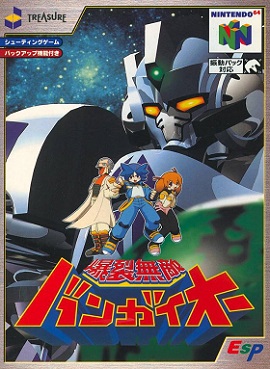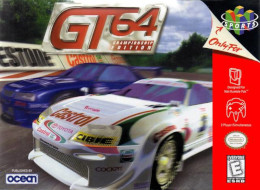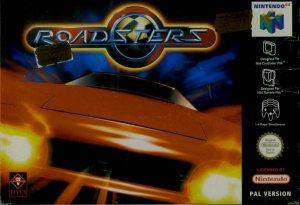
Chocobo Racing is a racing game developed and published by Square for the PlayStation, A spin-off of the Final Fantasy series and part of the Chocobo spin-off series. It was released in Japan in March 1999, followed by North America and Europe in August and October, respectively. The game's star and namesake is the Chocobo, with other figures from the Final Fantasy series, such as Mog the Moogle, the Black Mage, and Cid being part of the cast. Most of the game's soundtrack is composed using songs from previous Final Fantasy titles. As a formulaic kart racer, Chocobo Racing is often compared to Mario Kart and Crash Team Racing.

Bangai-O is a multidirectional shooter developed by Treasure and released in 1999 on the Nintendo 64 in Japan. It was ported to the Dreamcast worldwide shortly after with some gameplay changes and updated graphics and audio. The game places the player in control of a weaponized mech that can hover across large stages and fire at enemies all around them. The player must reach the end of each stage and defeat the boss, while avoiding hazards scattered across the map such as enemy mechs and gun turrets.

F-Zero X is a 1998 futuristic racing video game for the Nintendo 64 console, developed and published by Nintendo. It is a sequel to the original F-Zero (1990), and is the first F-Zero installment with 3D graphics. The game has a steep learning curve and its gameplay experience is similar to that of the original. An Expansion Kit, including a track and vehicle editor, was released in Japan in 2000.

Diddy Kong Racing is a 1997 kart racing game developed and published by Rare for the Nintendo 64. The game revolves around Diddy Kong and his friends' attempt to defeat the intergalactic antagonist, a wizard pig named Wizpig, through winning a series of races. The player takes control of any of the featured characters throughout the game. Diddy Kong Racing features five worlds with four racetracks each, and the ability to drive a car, hovercraft, or pilot an aeroplane.

Ridge Racer 64 is a 2000 racing video game developed by Nintendo Software Technology and published by Nintendo for the Nintendo 64. It is the first title of Namco's Ridge Racer series to not be on arcades or a PlayStation console, with Namco licensing the series to Nintendo to develop the game. In 2004, the game was ported and remade for the Nintendo DS as Ridge Racer DS, which uses the system's features such as the touch-screen and wireless multi-player. Additionally, Gina Cavalli from R: Racing Evolution replaced Reiko Nagase as the mascot in the DS version. The DS version also was not released in Japan.

Ogre Battle 64: Person of Lordly Caliber is a real-time tactical role-playing game developed by Quest Corporation and published by Nintendo for the Nintendo 64. Atlus released the game outside Japan. Though conceptually similar to Ogre Battle: The March of the Black Queen, significant gameplay tweaks were implemented to change the game's overall flow. Ogre Battle 64 is the third game in the series, the first two being Ogre Battle: The March of the Black Queen, and Tactics Ogre. Gaidens have been released in Japan, on Game Boy Advance and Neo Geo Pocket Color. Unlike earlier Ogre Battle games, which feature Queen song titles, "Person of Lordly Caliber" is an original title. Ogre Battle 64 was released in PAL regions for the first time via the Wii Virtual Console in 2010.

MRC: Multi-Racing Championship is a racing video game developed by Genki and released for the Nintendo 64 in 1997. It was published in North America and Europe by Ocean and in Japan by Imagineer. The game is compatible with the Controller Pak and the Rumble Pak.

Konami Krazy Racers is a 2001 kart-themed racing video game published and developed by Konami for the Game Boy Advance, released as a launch title for the system. Konami Krazy Racers makes use of a variety of characters and concepts from several of Konami's franchises, including Castlevania, Metal Gear, and Gradius. It plays similarly to the Mario Kart series, with eight characters per circuit and offensive/defensive items placed at predetermined points in the tracks. Konami Krazy Racers received mostly positive reviews. It was later released through the Virtual Console for Wii U in 2015.

R: Racing Evolution, released as R: Racing in PAL territories, is a racing simulation video game developed and published by Namco. It was released on the GameCube, PlayStation 2 and Xbox. It is a spin-off of the Ridge Racer series, released over three years after Ridge Racer V; unlike the main series, R: Racing Evolution is a simulator or simcade, and uses licensed racecars rather than fictional vehicles. The game centers around the character Rena Hayami in her career as a professional racing driver, and her rivalry with veteran driver Gina Cavalli, in a cinematic and story-driven plot. It received generally mixed reviews from critics.

Road Trip: The Arcade Edition, known as Gadget Racers in Europe and Choro Q! in Japan, is a racing video game released in 2002 by Takara. It is based mainly upon Road Trip Adventure, a predecessor, however was only sold for the GameCube. Allowing this, weapons were added to a more racing perspective to make it an arcade version. It involves toy cars known in as Choro-Q or Penny Racers.

AeroGauge is a hovercraft racing game designed for the Nintendo 64 game console and released in 1998. The game was developed by Locomotive and published by ASCII. It is conceptually similar to Psygnosis' Wipeout or Acclaim's Extreme-G. The main difference is that the vehicles in the game fly instead of hovering. AeroGauge garnered mediocre reviews, with criticism directed at its routine concept, excessive pop up, lack of weapons and power-ups, and overly high difficulty.

F1 Pole Position 64, released in Japan as Human Grand Prix: The New Generation, is a racing video game for the Nintendo 64 developed by Human Entertainment and published by Human Entertainment in Japan, and published by Ubi Soft for North American and Europe. It is the fifth and final game in the Human Grand Prix / F1 Pole Position series, featuring Formula One branding.

GT 64: Championship Edition, known as City Tour GrandPrix: Zen Nihon GT Senshuken in Japan, is a racing video game developed by Imagineer and released for the Nintendo 64 console in 1998. It is an official licensed game to All-Japan GT Championship, featuring cars and drivers of the 1997 All Japan Grand Touring Car Championship.

Magical Tetris Challenge is a 1998 puzzle video game developed and published by Capcom for arcades. It was ported to the Nintendo 64, Game Boy Color and PlayStation. It is a version of Tetris featuring Disney characters. It is one of the few Nintendo 64 games to be entirely in 2D, in addition to being Capcom's first game for the console. The Japanese arcade cabinet and cover art was done by Kenichi Sudo, while the North American cover art was done by Robert Griggs.

Monaco Grand Prix: Racing Simulation 2, also known simply as Monaco Grand Prix or Racing Simulation: Monaco Grand Prix, is a Formula One racing game developed and published by Ubisoft for Windows, Nintendo 64, PlayStation, and Dreamcast. It was released between 1998 and 1999. A sequel, Racing Simulation 3, was released in 2002.
Choro Q 64 2: Hachamecha Grand Prix Race is a racing game released in 1999 in Japan for the Nintendo 64. It is the sequel to Choro Q 64 and is part of the Choro Q series. The game is also compatible with the Game Boy Color game Choro Q Hyper Customable GB, using the Transfer Pak.

Roadsters is a racing game released by Titus Software for Nintendo 64 in 1999, and for PlayStation, Dreamcast and Game Boy Color in 2000. It is a car racing game that features both licensed cars from manufacturers and unlicensed cars from imaginary manufacturers that are based on and bear great resemblance to their equivalent, real car models. The game also includes a multi-player mode supports up to 2 human players that can compete in any of the available circuits with 4 more CPU controlled racers. A PlayStation 2 version was originally planned to release on April 11, 2001. Box art for unreleased PS2 game url=https://www.ign.com/games/roadsters

Penny Racers Party: Turbo Q Speedway is a 2008 racing video game developed by Barnhouse Effect and published by Takara Tomy for the Wii. It is part of the Choro Q video game series, which is based on Takara's toy line of the same name.

Penny Racers is a 1996 racing video game developed by Tamsoft and published by Takara for the PlayStation. Sony Computer Entertainment released the game in PAL regions. The game features cars based on Takara's line of miniature Choro Q / Penny Racers toys, and was the first game based on Choro Q released outside Japan since Taito's 1984 title on MSX.


















